Care for raspberries in spring /
Contents of
- When is it better to plant and replant raspberries: in spring or in autumn?
- How to plant and transplant raspberry in spring with seedlings: step by step instruction
- When to trim raspberries: in spring or in autumn
- How to cut raspberries in spring?
- How to propagate raspberries in spring?
- Spring treatment of raspberries from pests and diseases in early spring
- How to fertilize raspberries in early spring?
- Raspberry spring care: tips of seasoned gardeners
- Video: Raspberry care in the spring
In the field of truck farmers and gardeners, the site can not do without raspberry bushes. But, to ensure that the berries are large and sweet, and the bush is healthy, you should follow certain rules in planting, transplanting and pruning raspberries. In this article you will learn many interesting details.
When is it better to plant and transplant raspberries: in spring or in autumn?
Experienced gardeners believe that raspberry bushes can be transplanted at any time, with the exception of winter. Others advise to change transplants only in the autumn.
But still the main part of summer residents converges on the opinion that the transplantation should be performed in the spring, because the raspberry has already experienced the autumn temperature changes and winter frosts and it has grown strong enough. If you change a raspberry in the fall, but weakened or too young bushes can die from severe frosts.
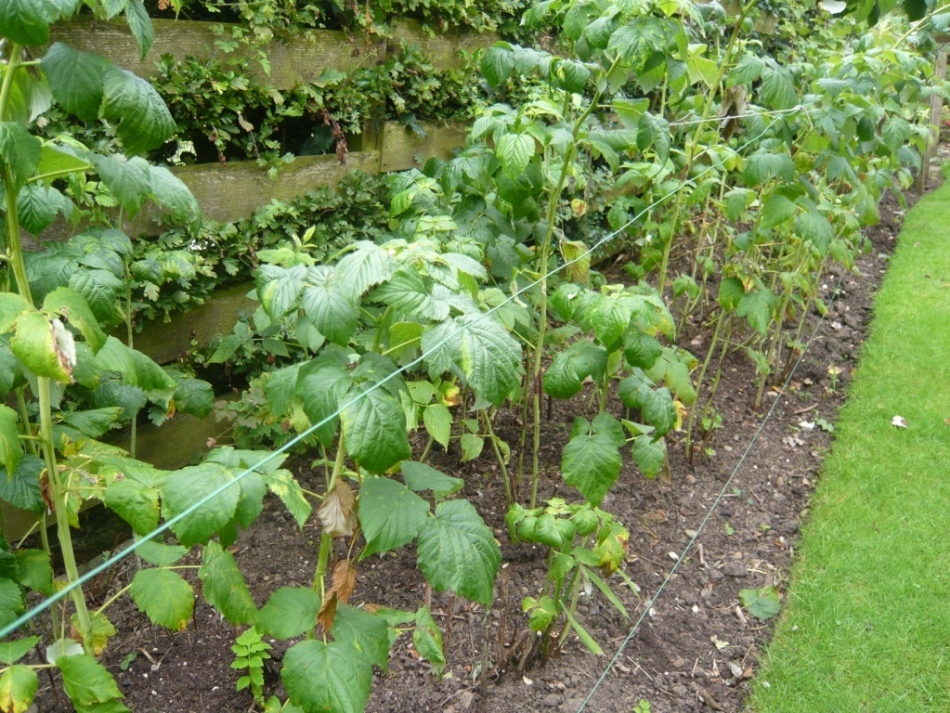 Planting raspberries in a trench
Planting raspberries in a trench A proper spring transplant guarantees you delicious and sweet fruits in the summer. And how to properly transplant bushes, you will learn further.
How to plant and replant raspberries in spring with seedlings: step by step instruction
So, let's start with the planting of crimson bushes:
- Choose a sunless, windless place with weakly acid or neutral soil.
- You can not plant raspberries in the soil, where tomatoes, potatoes or strawberries grew in the past year.
- Prepare wells - in spring planting - in autumn, with autumn planting - for a month.
- Plant bushes can be either in the holes, then in the bush should leave about 10 stems. Also raspberries can be transplanted into trenches - a tape method.
 Raspberry planting
Raspberry planting - When planting in the holes, it is necessary to make them 40x50 cm in size. In each well, pour in the mixture for planting, root, pre-moistened in the mullein, lower into the hole. Between the holes, determine the distance of 1 m, between rows - 2 m. The root neck should be at ground level when shrinking.
- Make a trench 45x50 cm between trenches within 1 m distance, bushes should be planted at a distance of 40 cm from each other. In the trench, pour a mixture of manure, topsoil and mineral fertilizers, double superphosphate is an excellent remedy.
- After planting abundantly pour the seedlings, but only if before it did not rain. Excessive moisture can damage plants. Create mulch from humus or peat. The height of the seedlings should not be more than 30 cm, all unnecessary must be cut off.
The transplant is similar to planting shrubs, but has its own nuances:
- Raspberry can grow up to 10 years in the same place. Over time, the soil loses mineral substances, and the bush will not be so fertile. This is an indication that the raspberries must be transplanted to a new location.
- Transplant should be only in places of sunny, without drafts. The soil at the transplant site should not be with nearby groundwater. Since the constant moistening of the bush will lead to rotting of the roots. Planting of raspberry
- In the prepared soil( how and when to prepare is indicated above), plant shrubs. For a transplant, it is better to use trenches, not holes.
- The distance between the bushes should be at least 0.5 m, so that the strengthened bushes do not create a shadow to each other. The depth of the trench is 40 cm, the diameter is 60 cm.
- After preparing the transplant site, dig out the raspberries from the old place. Be careful not to damage the roots.
- After digging, inspect the roots and remove the damaged or diseased parts.
- Gently plant the seedling in a pit and sprinkle with earth. Seal the soil and water the plant.
- So that the soil does not dry out quickly and the roots are well bonded to the ground, lay dry grass or sawdust around the bushes.
- If you can not find a place without a draft, then protect raspberry from the gusts of the wind - put pegs, and tie the bushes to them with a soft cloth.
- After transplanting for a few days daily pour a bucket of water under the bush. Conduct mulching.
- In the future, constantly clean the bushes from weeds and treat them with pest preparations.
Thus, you will get strong bushes and delicious fruits.
When to trim raspberries: in spring or in autumn
In order for raspberry bushes to bring juicy fruits, remember certain rules of trimming:
- It is advisable to trim raspberries in both autumn and spring. But if you do not plan spring pruning, then leave 10 shoots in the bush or 10 shoots per running meter in the trench.
- In case when spring pruning is still planned, then leave all strong and developed shoots in the fall, and in the spring inspect them, and if any part is frozen or broken, then such branches must be removed.
How to cut raspberries in spring?
Pruning raspberries in spring is an addition to the autumn pruning. This procedure has certain rules:
- As soon as the snow comes down, remove the shoots that hit frost or disease.
- Pruning of broken or damaged branches should be done near the ground so that infection or pests do not get into fresh cut shoots.
- Frozen shoots should be cut to healthy kidneys. The height of shoots should not be more than 1.5 m.
- Take into account the distance between bushes, proceeding from the fact that if you tie a raspberry, then there should be a distance of 10 cm between shoots.
 Raspberry pruning
Raspberry pruning - Do not leave too many shoots, sincetime they will shade each other, which will affect the number and size of the fruit.
- Experienced gardeners are advised to cut raspberries to different lengths - from 10 cm to ¾ of the shoot. Thus, the ripening of fruits will not be one-stage, but gradual and will last until August. After all, the fruit will first ripen on poorly trimmed shoots, and only then on those that have been cut off most strongly.
- Cutting shoots will affect the amount of yield, but for the better will be reflected in the size of the berries. In addition, this way you can enjoy delicious berries longer.
How to propagate raspberries in spring?
In order to grow several dozen raspberry bushes in the garden, it is enough to buy only one seedling. Raspberry propagates easily and quickly in several ways:
- Reproduction, using lignified siblings, which are formed on the root of the plant from the kidneys. Choose healthy shrubs and in the middle of autumn dig out the offspring. Focus on the sprouts that are 30 cm from the mother bush.
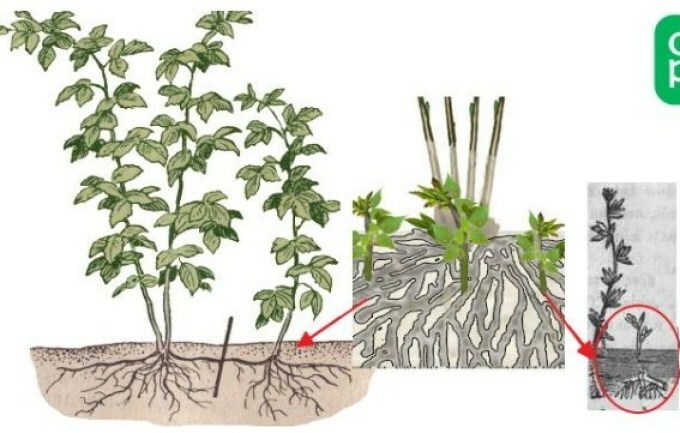 Raspberry reproduction
Raspberry reproduction - Look closely at the offspring - there should be no signs of disease or pests. To reproduce successfully the offspring should be strong and healthy. Leaves from offspring should be torn off.
- Reproduction with the help of green horse offspring. This method is suitable for spring breeding. The offspring should be about 20 cm high.
- Back off the center of the bush by 40 cm and scoop off the offspring. Plant them on a separate bed and cultivate until the fall, then the offspring can already be planted.
- Reproduction using root cuttings. If the bush is sick, then this method is optimal for the conservation and reproduction of the plant.
- In spring, excavate the earth 40 cm from the bush and excavate the additional root. Roots that have a diameter of more than 2 mm should be cut, retaining 2 kidneys and 10 cm in length.
- Dig up grooves 10 cm deep and lay cuttings in them one by one. Fill with water and during the whole summer water and loosen the soil.
- Reproduction using green cuttings. During the thinning of raspberries, select shoots of shoots that have been cut. Tie sprouts and place for a day in a solution of Heteroauxin 0.1%.After this procedure, plant the cuttings in the greenhouse. A month later, planted strong sprouts in the open ground.
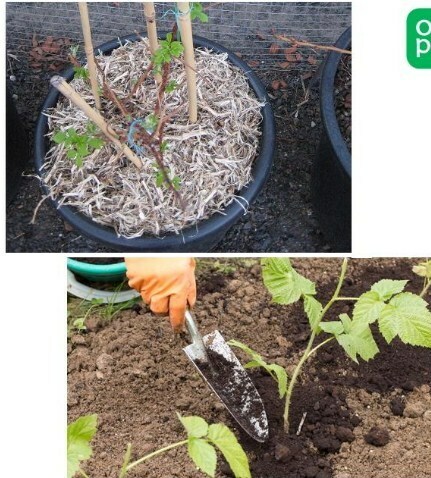 Propagation by green cuttings
Propagation by green cuttings - Breeding division reproduction. This method is especially good if you have a valuable and expensive grade of raspberries on the site. From one strong bush you can get 5 good seedlings. It is necessary to simply divide the bush, leaving behind a pair of strong shoots and well-developed roots from each seedling. Soak the bushes, carefully water and care for the seedlings.
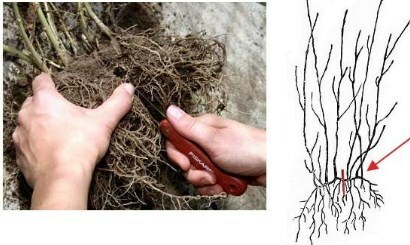 Propagation by the division of the bush
Propagation by the division of the bush You can propagate raspberry using any method. You can decide on the basis of the state of the bush, the season, and your desire.
Spring treatment of raspberries from pests and diseases in early spring
Raspberries are very often attacked by diseases and pests. Let's consider in detail how to save the plant from a variety of destructive attacks:
The plant turns yellow:
- This is the most common problem that causes a lot of concern among caring gardeners. But if you found the yellowness of the leaves in the fall, then this seasonal changes, which should not cause alarm.
- If you have found yellowness in the spring, then the cause may be root cancer or crookedness. In this case, not only do the leaves turn yellow, but the growths form on the roots, and the berries are no longer so sweet.
- When planting and transplanting, carefully inspect the roots for growths and, if found, immediately remove the affected areas. The place of the cut must be treated with copper sulfate.
 Raspberry leaves turn yellow
Raspberry leaves turn yellow - This symptom can also be caused by a mosaic attack - a viral disease, which is very difficult to cure. The only way is spraying shrubs with a remedy against aphids, but this is not a full-fledged panacea. You should carefully inspect the bushes and remove the affected areas.
- If the bushes are very close to each other, then it can also cause yellowing of the leaves. This is due to poor airing and insufficient light. Therefore, it is necessary to thin the bushes, and fertilize the plants with manure.
- If raspberries grow in moist soils with high acidity, then it can also provoke yellowing on the leaves. In order to eliminate the cause of yellowing, add 120 g * m² of gypsum to the soil and reduce watering.
Leaf curls:
- Sour berries and wrinkled leaves are a sign of a viral disease.
 Curse
Curse - There is no cure for this, so if you see such symptoms, you must immediately remove the affected bush from the site.
Mycoplasma disease:
- The formation of non-native shoots - the number of small shoots( up to 50 cm) can reach 200 pieces.
- It is urgent to destroy this plant, otherwise the disease can very quickly be transferred to other bushes. You can bring the pathogen to the site with planting material, so be careful when buying a plant.
Shrubs dry:
- Lean irrigation
- Lack of nitrogen
- Lack of sufficient lighting due to thick planting
If you eliminate the above reasons, but raspberries will stop drying. But there are also diseases that lead to raspberry drying. You will learn more about this later.
Rust:
- Raspberry can also dry because of a fungus, one of which is rust. This is expressed in brown ulcers on the leaves.
- It is impossible to heal rust, so the bushes will have to be excavated and destroyed.
- Preventive measures for the appearance of rust is the treatment of bushes in spring and autumn Bordeaux fluid.
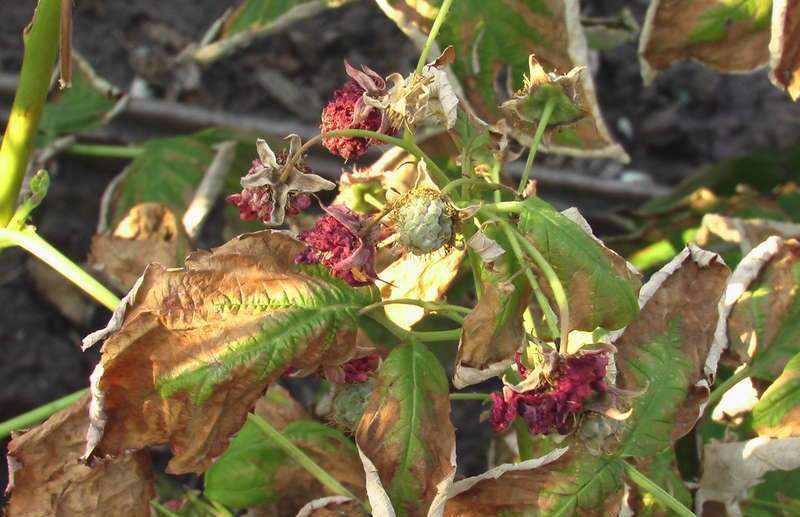 Raspberry rasp
Raspberry rasp Raspberry can also be affected by such diseases:
- Powdery mildew is a white coating on the leaves that causes them to dry out. You can heal a plant using any means from the fungus, but you only need to do this after harvesting the berries.
- Anthracnose are gray spots around which a purple bezel is formed. If you do not care for the bush, then over time, the spots grow and cover the entire leaf. Because of this, the leaves twist, the crust exfoliates from the stem. The berries do not ripen in this case. Means of struggle - drugs from the fungus - iron dystrophy, nitrafen.
 Anthracnose raspberries
Anthracnose raspberries Among the main pests can be identified:
- Tlja - lives on shoots or from below the leaves. Means of struggle - karbofos or aktellik, which should be used when budding the plant.
- Spider mite - settles from below the leaves and feeds on their juice. During dwelling, the raspberries are gradually enveloped in a web. Most often appear in hot weather without rain. The treatment will be spraying the plant with carbophos, phosphamide, colloidal sulfur, cidial, metaphos.
- Gallidity - this pest lays eggs in the damaged bark and in this case blisters are formed on the shoots - galls. Such shoots must be removed, and the land where they grew to dig up and be treated with carbophos.
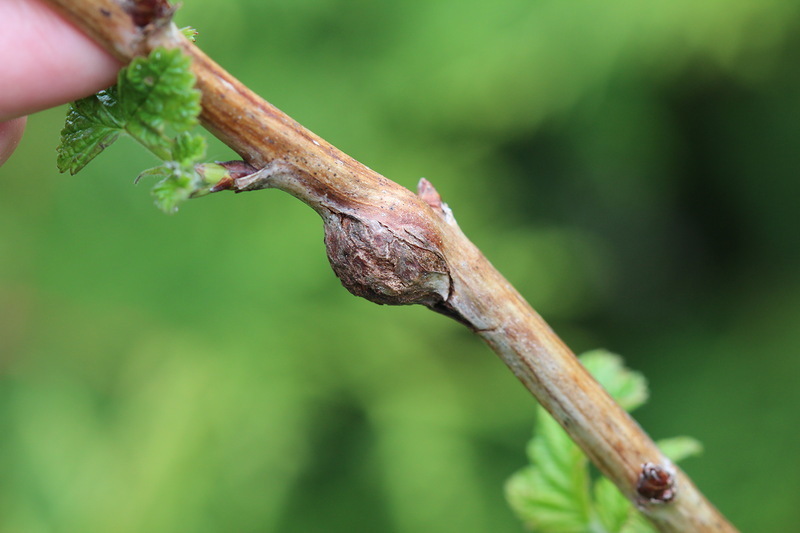 The stem gall midce
The stem gall midce - The raspberry beetle , which in winter is in the soil near the raspberry, and in the spring turns into buds. If you do not prevent the appearance of a beetle on buds, it will eat out flowering, thereby preventing the appearance of fruit. Treatment is spraying with carbophos, an athellicum or preparations with a similar action.
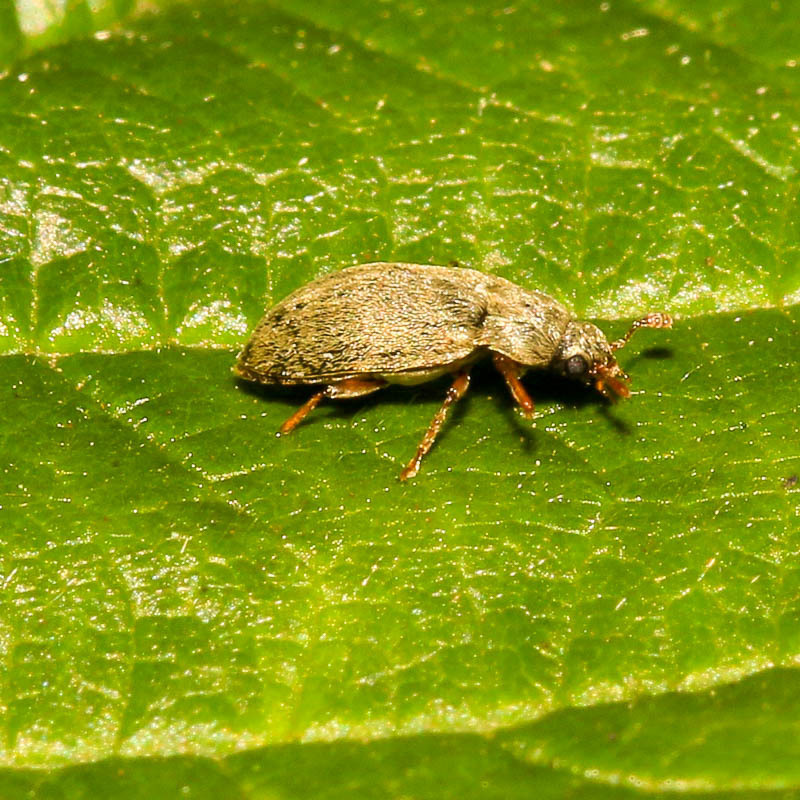 Raspberry Beetle
Raspberry Beetle - Weevil , which also like the previous pest feeds on flowering. The treatment of the plant from the weevil is identical to the previous one.
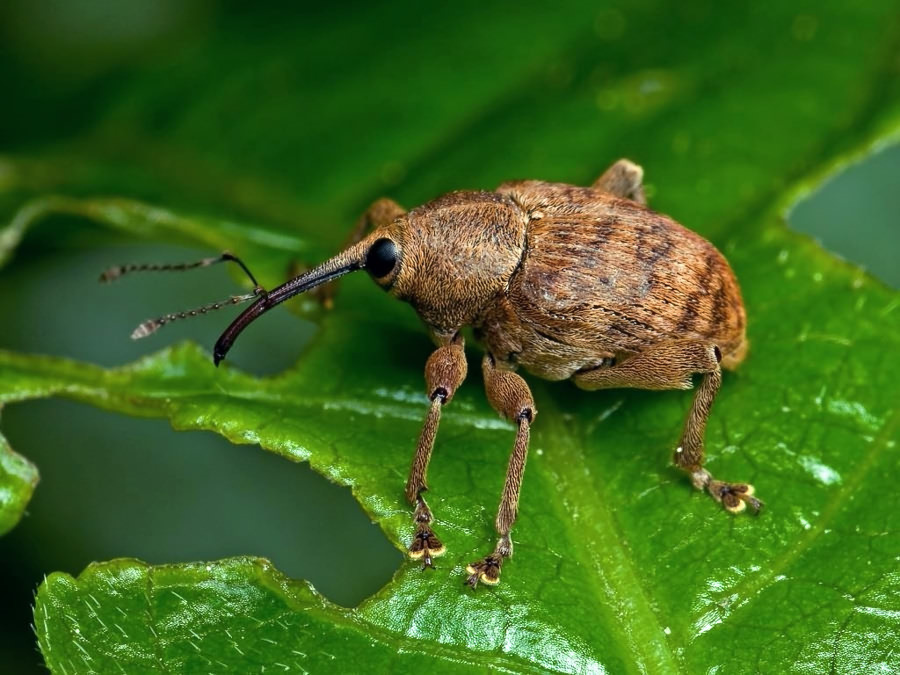 Raspberry weevil
Raspberry weevil - Bud mole - this pest gnaws the kidneys, and settles in the pulp of the shoot. It occurs in the early spring, and in May, having settled down, they are already engaged in laying eggs in the flowers of raspberries. Emerged young pests eat out the future harvest of raspberries. To prevent the appearance of moths, it is necessary to trim the shoots in autumn under the root, and in the spring to spray the plant with condi or carbophos.
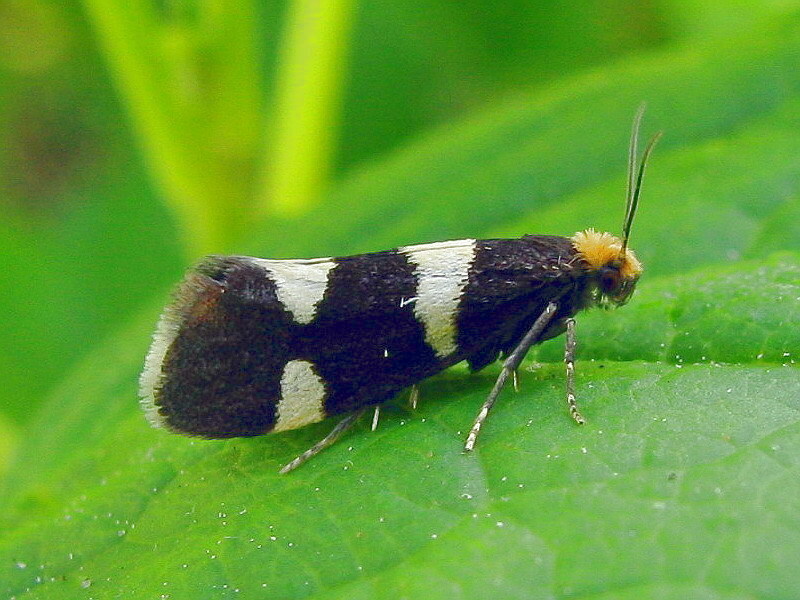 Raspberry mole
Raspberry mole - A stalk fly , which gnaws the inside of the stem and leads to drying and blackening of the shoots. It should be carefully examined shoots from the beginning of spring and throughout the summer, and in case of detection of the ear immediately remove damaged shoots and sprinkle the bushes with carbophos.
 Prophylactic spraying of
Prophylactic spraying of The preventive measures for treating raspberries in the spring are:
- Trimming frostbitten and damaged shoots in early spring
- Removing last year's leaves near the plant
- Spraying nitrafen or Bordeaux fluids twice: before bud blooming and in the summer when a disease is detected.
How to fertilize raspberries in early spring?
To raspberries gave a decent harvest, you should take care of the plant and properly fertilize the bushes. Focus on the appearance of the plant, to understand what kind of fertilizer is better, look at the appearance of raspberries:
- Lack of phosphorus - shoots weak, leaves small
- Lack of iron - yellow with green veins leaves
- Lack of magnesium - yellow on leaves that spreads from the middle of leaf
- Lack of nitrogen - small yellow leaves that do not grow
- Lack of potassium - brown edges on leaves, but also these symptoms may indicate an overabundance of nitrogen.
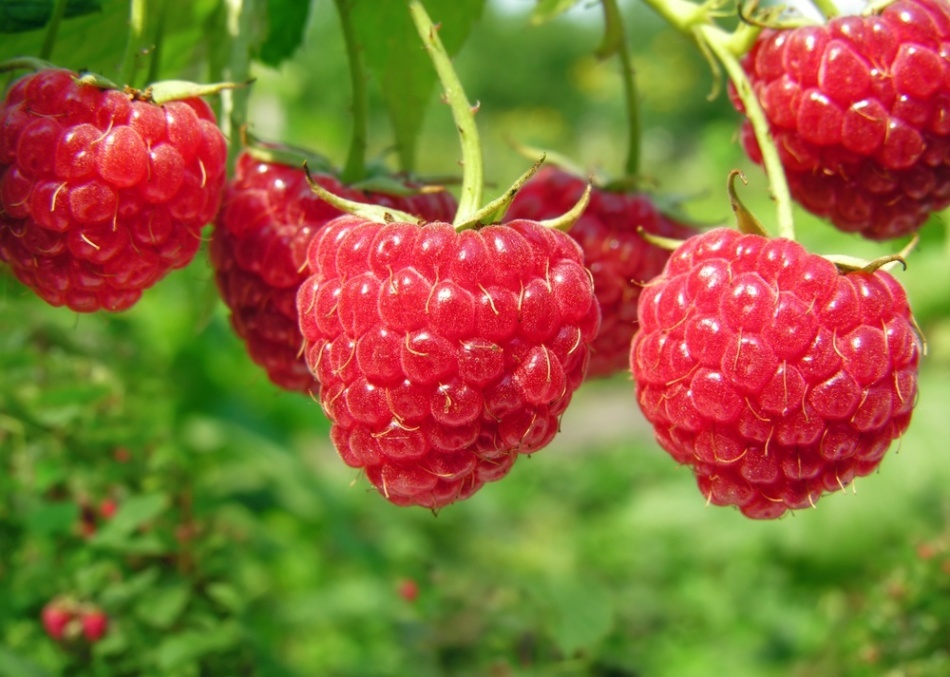 Raspberries need fertilizer
Raspberries need fertilizer Blast the soil with missing elements to eliminate painful symptoms. To prevent and improve yield, use superphosphate, as well as dry ash.
An excellent fertilizer is a mixture with superphosphate( 60 g), potassium salt( 40 g) and ammonium nitrate( 30 g).All components are poured into a bucket of water and watered 1 time in the spring and summer.
Raspberry spring care: tips of seasoned gardeners
To enjoy the sweet harvest and healthy shrubs you need to listen to the advice of gardeners:
- It is advisable to trim raspberries in the fall, if you did not have time to do this, then in the spring you need to prune immediately after the snow falls.
- Cleaning near the bushes should be carefully and regularly. This is especially true of the leaves that are broken, they must be carefully scraped out so as not to leave the soil for the propagation of pests.
- Weeding from weeds is also a necessary measure, because they, along with raspberries, feed on useful substances from the soil and help to weaken young shoots.
- Weeding very carefully, because the roots and shoots of the plant in spring are immediately near the earthen edge.
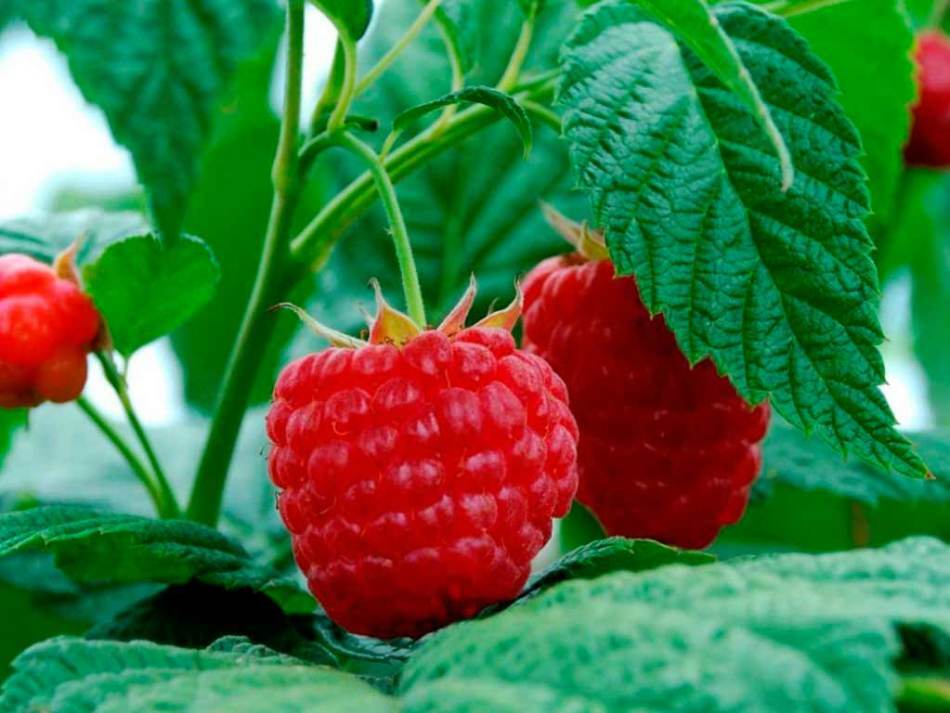 Carry out regular care for raspberries
Carry out regular care for raspberries - Tie raspberry bushes to promote better pollination and fruiting.
- Do not forget about regular watering, especially during the dry season. For better growth, add nutrients to the water.
- Be sure to use minerals and other top dressing to improve the condition of the plant, as well as take preventive measures in the fight against pests.
This set of activities will help you get a decent harvest of sweet and large berries.
Video: Raspberry Care in Spring
